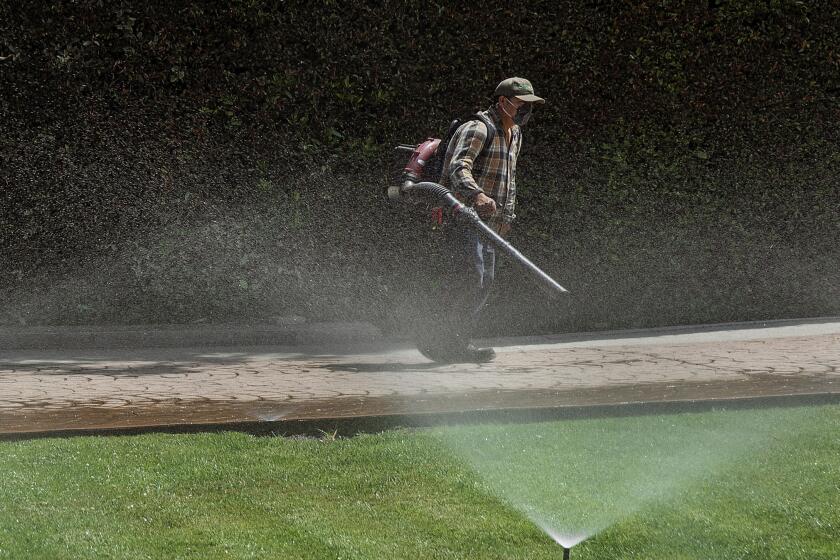Frost Busters : Nurserymen Fire Up the Smudge Pots in Efforts to Save Their Cold-Sensitive Plants From Damage
- Share via
Aldo Claudio got the call about 10 p.m.
“It’s down to 30,” Ignacio Oceguera said.
That meant it was already well below freezing at the 500-acre Monrovia Nursery in Azusa, probably the largest agricultural operation--in terms of sales and employees--in Los Angeles County.
And that meant, for about the 10th time this winter, that it would be up to Claudio, a nursery foreman, and two employees, Cesar Reynoso and Leopoldo Carrasco, to save a large portion of the nursery’s sensitive crops from frost.
So after hearing from Oceguera, the nursery’s night watchman, Claudio grabbed a jacket, jumped into his pickup truck and quickly drove the 20 miles to Azusa from his home near Chino.
During the next nine hours, the three men plied the miles of narrow dirt roads on the hillside acreage, reading thermometers and lighting and tending scores of “smudge pots”--little oil-fired stoves that can raise outside temperatures the 2 or 3 degrees that can make a critical difference.
“It’s a cold job,” Claudio admitted at about 4 a.m. Tuesday as he and Reynoso huddled for a brief break beside a glowing pot on a dark, wind-swept ridge.
“But it works,” Claudio said. “These things really do work.”
For most Southern Californians, cold weather usually means a little discomfort, minor inconvenience and perhaps a frozen flower bed or two.
For the Monrovia Nursery and other similar, if smaller, operations in the county, it can mean economic disaster.
In 1978, a pre-Christmas freeze cost the nursery hundreds of thousands of dollars worth of plants, according to Roger Duer, a spokesman for the firm.
Ranchers Lost Millions
In 1949, back when agriculture was still one of the biggest industries in Los Angeles County, citrus ranchers in the Azusa area lost millions of dollars in frozen fruit and frost-ravaged trees.
They used smudge pots back then, too. Thousands of them. They were the old-fashioned kind that belched a pall of oily black smoke that could obscure the sun until mid-morning. The problem in 1949 was that it got so cold--down to 19 degrees in some areas--that the smudge pots didn’t do much good.
On Tuesday morning, the pots did a lot of good.
For one thing, they are of a modern design, relatively smokeless and much more efficient.
For another, the mercury dipped to only 29 degrees.
And for another, it’s February, not November.
“In November, the plants are still ‘soft,’ still growing, much more sensitive,” Duer said. “By this time of year, they’re ‘harder,’ more dormant. They can tolerate frost a little better.”
Need Help to Survive
Nonetheless, there are a lot of plants at the nursery that cannot survive temperatures much below freezing without help--plants such as hibiscus, azaleas, banana trees and citrus seedlings.
The nursery places the most-tender plants in “hoop houses”--little plastic tents, shaped like World War II Quonset huts, that are heated with thermostatically controlled gas burners. With the help of the burners, temperatures in the huts remained well above freezing Monday night and Tuesday morning.
Plants that are a little tougher, but still relatively frost sensitive, are grouped around “wind machines”--motor-driven airplane propellers mounted on short towers, that stir up currents to keep the coldest air from settling near the ground. Smudge pots are often used in conjunction with these machines. Thermostats started the wind machines before midnight Monday as temperatures slid below freezing.
Still-tougher plants--those that can tolerate temperatures down to about 29 or 30, are protected by smudge pots alone, spaced about 50 feet apart.
Temperatures Vary
Because the terrain on the sprawling acreage above Azusa is uneven, temperatures can vary as much as 8 degrees. So Claudio, 23, Reynoso, 23, and Carrasco, 34, immediately began checking the thermometers scattered across the property. The checking would continue throughout the night.
As temperatures in critical areas dropped below the danger point, the three men began lighting the pots, using torches fueled with a mixture of gasoline and diesel oil. By 4 a.m., they had fired up about 150 pots, enough to keep temperatures from dropping below 29 degrees.
Finally, shortly after sunrise, the thermometer readings began climbing back up into the high 30s. The wind machines clicked off, and within half an hour, the three men had snuffed out all the smudge pots. It was 7:30 a.m., and it looked as though all the plants had escaped unscathed.
“Time for bed,” Claudio said.




